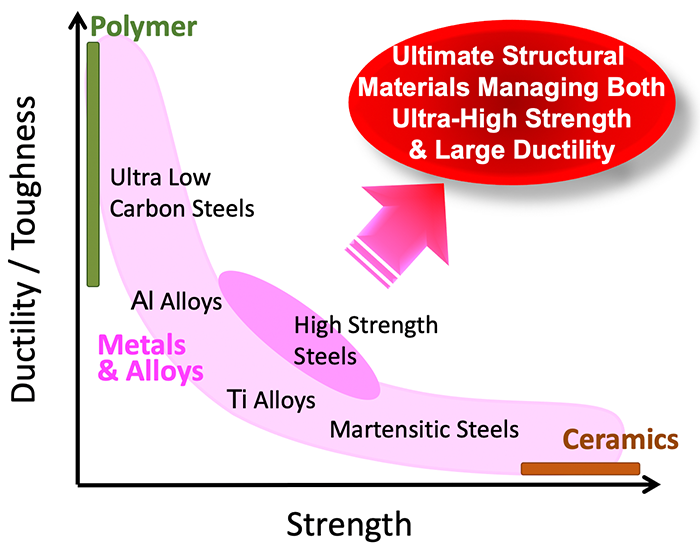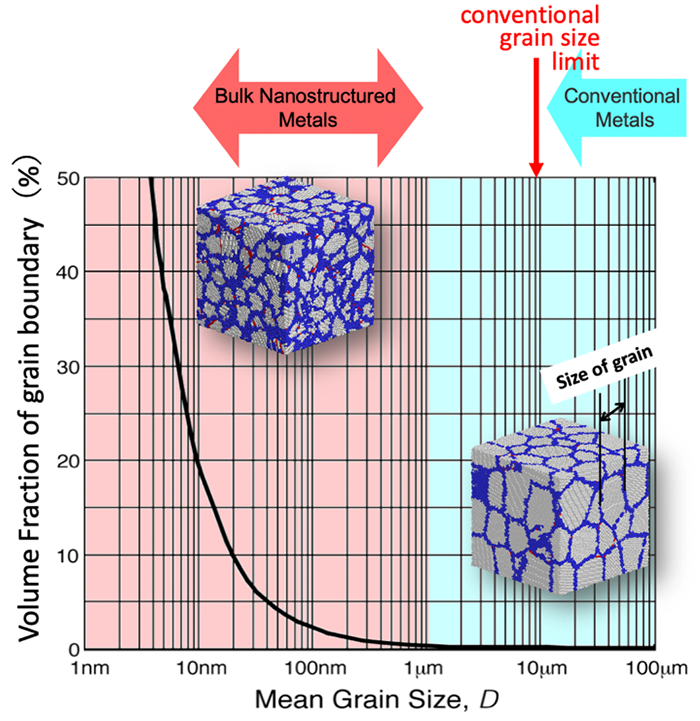In the pursuit of lightweight transportation equipment and the construction of large-scale architectural structures, there is an unprecedented demand for structural materials with ultra-high strength to bear mechanical functions. However, in the realm of materials, including metals, a generally observed trade-off exists where an increase in strength compromises ductility and toughness. Achieving both ultra-high strength and high ductility/toughness represents one of the most critical and challenging objectives in current structural material development. Despite this, the atomic-scale mechanisms underlying the activation of various deformation processes and the improvement of work hardening, essential for realizing high strength and ductility, remain elusive. Consequently, guiding principles for determining the chemical composition and structure of materials to achieve these properties have not yet been established. This study integrates cutting-edge experimental techniques in material nano/micro-structure control and mechanical property analysis with the latest computational materials science methods, encompassing first-principles and atomic-scale simulations along with data science. Through international collaborations among leading researchers, it aims to acquire the guiding principles mentioned above and to innovate in material creation. While the combined use of experimental and computational approaches has become increasingly common in advanced material research, significant unexplored areas remain, particularly in elucidating the dynamic and complex mechanical response phenomena. Especially within the field of structural materials, a divide persists where experimentalists focus solely on experimentation, and theoreticians on computation, hindering the efficiency and breakthrough progress of collaborative research. In this project, we consider that young researchers with a dual understanding of both experimentation and computation are key to achieving significant breakthroughs in next-generation structural material research. It seeks to cultivate a new generation of dual-sword-skilled researchers in materials science by providing young researchers with intensive training at leading experimental and computational sites worldwide.
Compared to conventional bulk polycrystalline metals, which have an average grain size of more than 10μm, bulk nanostructured metals (BNMs) with a grain size of less than 1μm are essentially "full of grain boundaries." Near these grain boundaries in polycrystalline metals, atoms adopt a local arrangement different from that in grain interior to maintain the bond between adjacent grains, leading to significantly different physical and mechanical properties in BNMs. For instance, BNMs can exhibit ultra-high strength, more than four times that of conventional metals. However, many BNMs suffer from a significant reduction in ductility due to early onset of plastic instability, failing to achieve both strength and ductility. Recent findings, however, have shown that certain annealed metals and alloys with ultrafine grain microstructures (a class of BNMs) can achieve both high strength and ductility. The mechanisms facilitating this combination of properties were identified as follows:
Recent findings, however, have shown that certain annealed metals and alloys with ultrafine grain microstructures (a class of BNMs) can achieve both high strength and ductility. The mechanisms facilitating this combination of properties were identified as follows:
- In metal crystals, a multitude of dislocations readily slide to enable plastic deformation.
- Annealed metals possess a dislocation density of 1012 to 1013 [m/m3]. In coarse-grained polycrystals with grain sizes larger than 10μm, 100 to 1,000 dislocations exist within each grain, facilitating large-scale plastic deformation through sliding and multiplication.
- Conversely, in bulk nanometals with grain sizes less than 1μm, only 1 to 10 dislocations are present within each grain under the same dislocation density, leading to exhaustion of dislocations and consequently, a significant increase in stress (enhanced strength).
- As a result, deformation mechanisms that do not typically operate in conventional metals (such as special slip systems of dislocations, twinning, martensite, etc.) become active in BNMs.


The increased work hardening due to the mechanical interaction between activated deformation mechanisms or between these mechanisms and the nano/micro-structure suppresses plastic instability, resulting in high strength and ductility.
To realize these mechanisms, this research aims to (a) design alloys (chemical composition) that activate otherwise inactive deformation mechanisms and create optimal nano/micro-structures for various metals and alloys, (b) elucidate the atomic-scale mechanisms behind the activation of deformation mechanisms, and (c) understand the mechanical interactions between activated deformation mechanisms or between these mechanisms and the nano/micro-structure. Achieving these objectives will involve collaboration between experimental and computational (including data science) approaches to explore alloys through data science, create nanostructured materials using advanced processes, conduct atomic-scale computational mechanics analyses and validate them with advanced electron microscopy, and perform state-of-the-art in situ deformation analysis and large-scale mechanical simulations. These integrated approaches seek to acquire guiding principles for designing ultimate materials that reconcile high strength with high ductility.